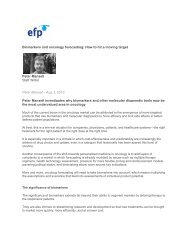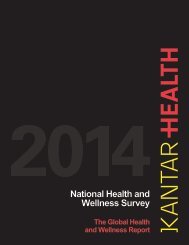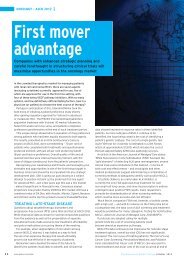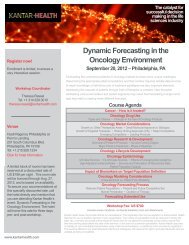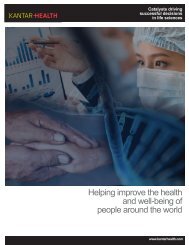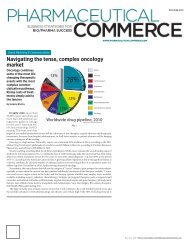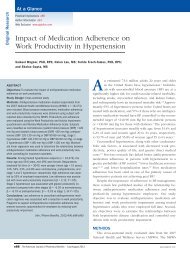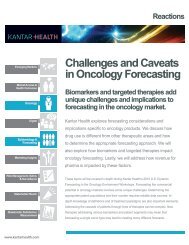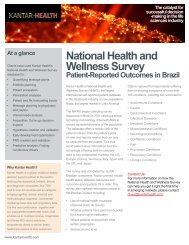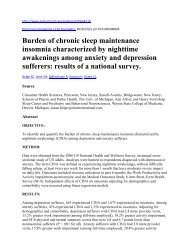Diabetes in India - Kantar Health
Diabetes in India - Kantar Health
Diabetes in India - Kantar Health
- No tags were found...
You also want an ePaper? Increase the reach of your titles
YUMPU automatically turns print PDFs into web optimized ePapers that Google loves.
DIABETES IN INDIAtrends, symptoms, diagnosis, treatment anddisease monitor<strong>in</strong>g processes and <strong>in</strong>volv<strong>in</strong>g 1434patients across 15 <strong>India</strong>n cities (<strong>in</strong>clud<strong>in</strong>g Mumbaiand Delhi) and tier one towns (eg, Jaipur,Hyderabad, Lucknow, Coch<strong>in</strong>.“ … <strong>in</strong> Ch<strong>in</strong>a and <strong>India</strong>record prevalence of Type 2is predicted for 2030 … ”Family history also has a part to play … or doesit? Unlike diabetes hot spots like Ch<strong>in</strong>a and theUS – where risk factors are often hereditary –almost two-thirds of the <strong>India</strong>n patients <strong>Kantar</strong><strong>Health</strong> spoke to who had developed diabetesdid not have a family history of the disease.Although this discrepancy could be attributed tothe lack of formal records, this is unlikely to bethe case – were it so you would also expect to seesimilar trends <strong>in</strong> patients <strong>in</strong> rural areas <strong>in</strong> Ch<strong>in</strong>a.Cost and treatment coverageCost of care is a potential issue <strong>in</strong> <strong>India</strong> and isimpact<strong>in</strong>g both diagnosis and treatment. Around50 per cent of our sample were either employed orself–employed, and just 7 per cent had employerrelated<strong>in</strong>surance to cover their treatment.Medical <strong>in</strong>surance penetration <strong>in</strong> <strong>India</strong> is generallylow, even among more affluent patients, anddiseases such as diabetes are often not coveredby <strong>in</strong>surance policies. The region also suffers froma lack of <strong>in</strong>vestment <strong>in</strong> treatments: less than 1 percent of worldwide diabetes spend<strong>in</strong>g is spent <strong>in</strong><strong>India</strong> compared with the US, which accounts forover half of worldwide diabetes expenditure.“Medical <strong>in</strong>surancepenetration <strong>in</strong> <strong>India</strong>is generally low, evenamong affluent patients”As well as putt<strong>in</strong>g pressure on healthcareexpenditure, the economic burden – lostproductivity and economic growth – of diabeteslooms large, with the greatest burden be<strong>in</strong>g thecosts associated with disability and loss of life asa result of the disease and its complications.The World <strong>Health</strong> Organisation (WHO) predictednet losses <strong>in</strong> national <strong>in</strong>come from diabetesand cardiovascular disease of Int$557.7bn <strong>in</strong>Ch<strong>in</strong>a and Int$336.6bn <strong>in</strong> <strong>India</strong> between 2005and 2015. In <strong>India</strong> around 70 per cent of Type2 diabetes patients were diagnosed when theywere under 50 years-old, suggest<strong>in</strong>g that theirwork<strong>in</strong>g life was likely to be cut short.Poor disease awarenessAlongside affordability and the lack of treatmentfund<strong>in</strong>g, poor awareness of the disease isimpact<strong>in</strong>g the treatment pathway. Type 2diabetes can rema<strong>in</strong> undetected for many years,and diagnosis often results from associatedcomplications or accidently as the result ofan abnormal blood or ur<strong>in</strong>e glucose test.A recent social media study conducted amongdiabetes patients <strong>in</strong> Ch<strong>in</strong>a found they take theirdisease seriously, with over three-quarters go<strong>in</strong>gonl<strong>in</strong>e to discuss the pros and cons of therapies,diet and lifestyle. However, it seems that <strong>India</strong>npatients do not have the same approach. Onlyone-third of our <strong>India</strong>n sample could correctlyidentify the type of diabetes they have, and 93per cent were not aware of their BMI. Although50 per cent of the <strong>India</strong>n sample was overweight(compared with a whopp<strong>in</strong>g 90 per cent <strong>in</strong> the USand 41 per cent <strong>in</strong> Ch<strong>in</strong>a) and recognised weightas a contribut<strong>in</strong>g factor <strong>in</strong> their disease state,they blame stress as be<strong>in</strong>g the ma<strong>in</strong> cause.“Alongside affordability… poor awareness ofthe disease is impact<strong>in</strong>gthe treatment pathway”Patients <strong>in</strong> Ch<strong>in</strong>a and the US are activelyseek<strong>in</strong>g out solutions and educational helpfor their diabetes. However, a traditionalsegmentation of patients <strong>in</strong> <strong>India</strong> revealed that37 per cent fell <strong>in</strong>to the ‘careless and casual’category and another 18 per cent <strong>in</strong>to the ‘defiantnon-followers’ segment, mean<strong>in</strong>g that over 50 percent of our sample were <strong>in</strong> denial and/or lackedthe discipl<strong>in</strong>e required to comply with prescribedtreatment regimen. Three out of four had neverhad an HbA1c test and while most compliedwith doctor and specialist recommendationsregard<strong>in</strong>g frequency of diagnostic tests, doctorvisits and brands purchased, around 64 per centskipped doses. Most patients were not tak<strong>in</strong>g anycorrective actions <strong>in</strong> terms of diet and lifestyle.Engag<strong>in</strong>g the non-engagedThese non-compliant patient groups shouldbe targeted with market<strong>in</strong>g campaigns andmessages that are different from thoseaimed at compliant patient segments. Buthow can pharma <strong>in</strong>fluence patients <strong>in</strong> <strong>India</strong>who don’t want to comply or are <strong>in</strong> denial?In common with their counterparts fromCh<strong>in</strong>a and the US, diabetes patients <strong>in</strong> <strong>India</strong>are <strong>in</strong>creas<strong>in</strong>gly connect<strong>in</strong>g with otherpatients us<strong>in</strong>g social media and other onl<strong>in</strong>ecommunication tools. A random sample of1,030 Type 2 sufferers <strong>in</strong> urban <strong>India</strong> showedthat 12 per cent go onl<strong>in</strong>e at least once a week32 www.pmlive.com/pme Pharmaceutical Market Europe November 2012



